The Role of Music in African Cinema
Even today, an analysis of the complex role of music in film is often forgotten by critics, many of whom remain prostrate before the dictatorship of the image. Yet as a manifestation of culture, music has a privileged position with respect to the study of representations of identity and ideology; moreover, in its subversive and dialogic aspects, it can reveal significant directorial decisions related to dynamics of power and exclusion.
Considering this in light of its importance within numerous African cultures, we must conclude that an exploration of the place of music remains a desideratum in the study of African cinema. For the first five decades of African cinema, music’s significance was understood with reference to certain programmatic ends, as when Ousmane Sembène and Djibril Diop Mambety devoted themselves to constructing the image of their newly created nations. Their pioneering work dealt with the necessity of recovering a historical memory intentionally obscured by imperialism and of developing alternatives to colonial and neocolonial dogmas. Moreover, they sensed the urgency of elaborating a body of specifically African theory related to social and cultural praxes in their respective cultures. In this environment, the role of cinema was crucial. This new art form, fusing the potency of the audio-visual idiom and the complex legacy of imperialism, came to be seen as a privileged means of struggle against the injustices in these directors’ daily lives. They were conscious both of the complicated nature of the problems they faced and of the power of cinema, through image and especially sound, to construct an authentically African identity in opposition to the reactionary conceptual paternalism propounded from the West.
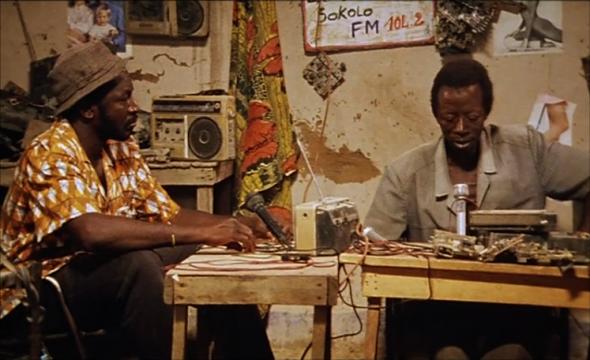 La vie sur terre, 1998, Abderrahmane Sissako.
La vie sur terre, 1998, Abderrahmane Sissako.
But over time, music’s import has grown, and today one may find, in the work of certain auteurs, a notable maturity in the treatment of diverse musical traditions that defies easy categorization. In the works of both Abderrahmane Sissako and Moussa Sené Absa—not to mention the musicals of Flora Gomes, Joseph Gaï Ramaka and Mark Dornford-May—music plays an essential role in understanding of the meaning of the directorial process. Their films are at once critical and artistically significant in their experimental nature—with respect to form as much as to content—and they exemplify the impossibility of reducing the role of music to a set of indiscriminately applicable generalities.
Since the early days of African cinema, music has formed part of a (self) conscious discourse concerning the problematic realities of Africa. Its use has rarely been gratuitous and goes far beyond the traditional—and much less experimental—Western customs of dramatic punctuation, of evocation of place, of establishing an emotional relationship with the spectator in which the image is almost always predominant, or as accompaniment to the never-ceasing rush of action that hardly leaves one time to think… In African cinema, music is stressed in terms of its cultural, poetic, and artistic functions in relation to oral tradition, with reference to such figures as the griot; it is used to critique the reductive commonplace of tradition versus modernity employed by partisans of a fabricated, purist, and ultimately nefarious—in its insistence on the notion of an “unadulterated essence”— “return to the roots”; it is blended into narration as an essential component and as a marker for critical moments; it works to evoke spaces where time slackens and opens up, giving way for ambiguity and reflection; and it mirrors the continuing urbanization of every aspect of African life, its constant contact with a West for which music is often a tool of domestication, of modernization, and of cultural imperialism.
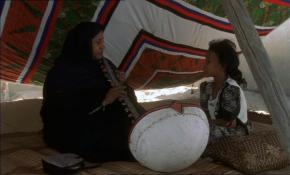 Heremakono, 2002, Abderrahmane Sissako.
Heremakono, 2002, Abderrahmane Sissako.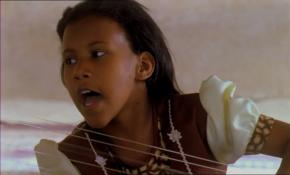 Heremakono, 2002, Abderrahmane Sissako.
Heremakono, 2002, Abderrahmane Sissako.
A closer attention to the use of music in African cinema remains necessary not only for critics and lovers of African film, but for anyone concerned to better understand music’s place in African’s lives. For cinema is more than the artistic consciousness of a people; it is a window into their desires, passions, and frustrations, and attending to it in earnest, we may see beyond those sterile, reductive commonplaces so beloved of certain theorists in the West.
Directors, Griots, Coreographers
Papa Wemba said to me: “If I was not a musician of contemporary music and if I had lived in my village, I would be a griot”.
Mweze Ngangura
J’adore la musique et tous mes films sont une ode musicale.
Moussa Sené Absa
The work and trajectories of four directors in particular suggest the growing significance of music to African cinema. Despite their diverse geographic, ethnic, and linguistic provenance, each personifies, in specific ways, the revaluation of the auditory in moving pictures. The entire ouvre of the francophone directors Aberrahmane Sissako (Mali) and Moussa Sené Absa (Senegal), the groundbreaking musical comedy Nha Fala of the lusophone Flora Gomes (Guinea Bissau), and the thematization of music in the European diaspora in Mwenge Ngangura (born in the Democratic Republic of Congo, but a longtime resident of Belgium) draw our attention to the constant dialogue between musicians and directors in which the importance of the former is reasserted—a tendency now common throughout the African continent.
The concept of the griot-as-narrator, while useful for an analysis of the aforementioned directors, must be broadened to take account of the importance of dance and, especially, choreography. Music, in this connection, serves as a vehicle for the propagation of critical and artistic stances in relation to diverse aspects of African identity. Abderrahmane Sissako, for example, proceeds from the Mandé tradition, for which the kora is the instrument par excellence and in which words and music go hand in hand; his works, based in the oral tradition, present the griot as conscious of his duty to re-elaborate and transmit a deeply personal discourse through a cinematic idiom anchored in poetry and music, but choreographed with people and situations. Moussa Sené Absa, in his life and works, draws on the idea of the géwël, the Wolof interpreter of traditions, whose art is characterized by singing and by sabar percussion. Both directors manifest a fondness for polyrhythm and, in this way, a fidelity to West Africa’s musical heritage, but in the case of the latter, the idea of téranga is equally indispensable. Flora Gomes’s dreamed Africa, while distant from the idea of the griot, is nonetheless rooted in communitarian ideals in which the recovery of music and dance inaugurate, for her subjects, a broader personal liberty; and Mweze Ngangura leads us to reflect, with great poignancy and suggestiveness, on the adversities of emigration to Europe—a signal aspect of contemporary African life, and one in which the role of cinema and music in keeping alive cultural and artistic traditions is crucial. These directors’ esthetic shows the futility of resorting to mere discourse in order to combat the generalizations that have so long plagued artistic representations of African life: in its place, they propose an encounter between the cultural richness of their native cultures and the techniques of contemporary art. That all four have privileged music in their art underscores its importance as a subject of the continuing discourse among theory, practice, and critique as they relate to the conceptualization of African film.
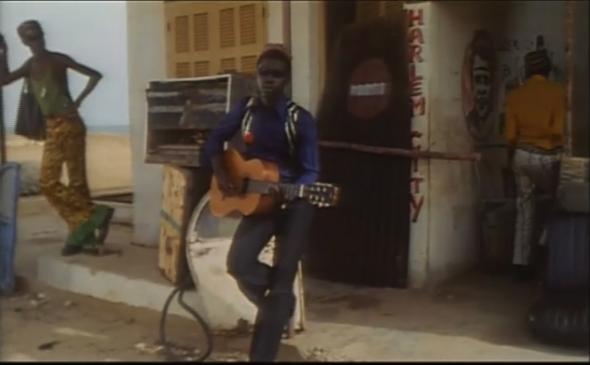 Ça twiste a Poponguine, 1993, Moussa Sené Absa.
Ça twiste a Poponguine, 1993, Moussa Sené Absa.
Mousa Sené Absa: A paradigmatic case
In my films, music is a character, not something I tack on afterwards to match the image. When I write the script, what comes to mind first is the music.
From the earliest stages of a film’s production, Moussa Sené Absa (Dakar, 1958) gives careful attention to its musical aspects. It is to the polyrhythmic tradition of the sabar that the director hearkens as a point of departure for his words and images, giving music itself a starring role. Sené Absa acts as dirigeur of the sabar ensemble, marking time, deciding the order of the songs, instructing the dancers and keeping the public alert… In bringing together the functions of composer, director, and choreographer, he creates works in which music opens up spaces for the consideration and questioning of diverse aspects of reality—exactly as it does in life.
Sené Absa belongs to the so-called third or post-independence generation of foreign-educated directors born in countries no longer subject to the colonizers’ yoke, whose conflicts and realities were distinct from those faced by the pioneers who preceded them and whose openly militant works emphasized the struggle for independence. It was Djibril Diop Mambety who marked out a new path, departing from the social realism of Sembène and his followers, and it is no coincidence that Sené Absa had his start as the Mambety’s assistant, learning at his side the finer points of that medium in which, years later, he would produce a distinguished body of work with a thirst for innovation reminiscent of his mentor’s.
Sené Absa’s family—people dedicated to “storytelling and music and words and images, and oral tradition,” as he has stated—introduced him to the artistic way of life long before he cut his teeth on the film set. He himself represents the total artist, painting, writing, composing, singing, and dancing, all with great skill. Sené Absa privileges music as a protagonist in its own right, and employs it to endow his films with a polyrhythmic structure. In an attempted revision of the griot concept—summed up in Sembène’s formulation of the cinéaste as modern griot, and grown thin through overuse among theorists of African cinema—Sené Absa presents himself as a director-cum-choreographer, but with a broadened frame of historical and cultural references: the Wolof percussionists of the sabar in particular, and the Wolofization of Senegalese society, especially widespread in the urban areas in which Sené Absa was born and raised.
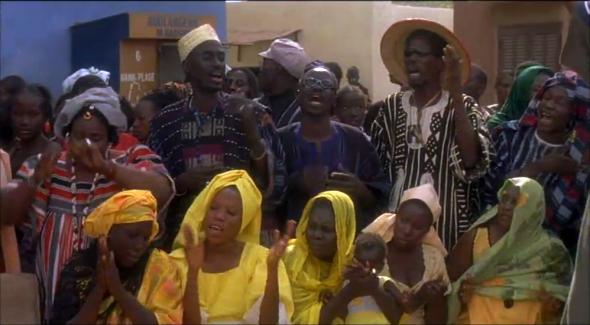 Madame Brouette, 2003, Moussa Sené Absa.
Madame Brouette, 2003, Moussa Sené Absa.
The importance of the sabar to Senegalese culture cannot be overestimated: it is played to commemorate births and deaths, as an accompaniment to Laamb, also known as la lute sénégalaise, the traditional folk wrestling that enjoys the status of national sport, the many women’s ceremonies, and even political summits. Its significance to the ouvre of Sené Absa is therefore a matter of course. Music dictates the structure of his films, from the composition of the script to the choreography and even the positioning of the camera, and in the montage phase, these elements are painstakingly arranged according to a polyrhythmic model, after the fashion of a sabar gathering, in which care is taken to avoid the privileging of narrative and image that deprive the musical element of its distinctive virtues. These trends have been evident across a variety of formats since his 1988 directorial debut: in 35mm, in video, and in his popular television series.
In his first full length film, Ça twiste à Poponguine (1993), Sene Absa makes use of video in order to cast a look back at French Pop and American R&B in the context of adolescent rivalries of the 1960’s in a Senegalese fishing village. The theme is music itself: occidental music as a metaphor for the fascination exerted by Europe, and especially by France and French celebrities, among the Senegalese youth of the director’s generation. Years later, in the autobiographical Ainsi muerent les anges (2001), music serves both as a consolation for and a marker of the bitter isolation faced by the African exiled in Europe. It is not for nothing that, in the decisive moment when the protagonist flees from his home in France, he takes refuge in the bar of a countryman and asks a griot there to play for him: nothing, save for the soothing embrace of alcohol and the singer’s familiar melodies, can calm him before his return to his motherland, where he will face the uncomprehending judgment of his father and his former friends. One of Sené Absa’s key innovations is the explanatory musical excursus, an experimental technique repeated to great effect in his second feature, Madame Brouette (2002). His most recent work, Téranga Blues (2005), deepens these explorations of the fundamental role of music. In the first, he presents us with a kind of musical in which the interjections of a group of griots punctuate the action while contemporary African pop songs play in the bar where much of the plot unfolds. In the second, the concept of téranga, the focal point of the film’s drama, is linked both to the plaintive desperation of the blues and to a rendering of traditional music as a metaphor for the tranquil honesty of the artist’s path, which implies, regardless of its austerity, a proper understanding of téranga, opposed to the fast life with its easy riches and complications.
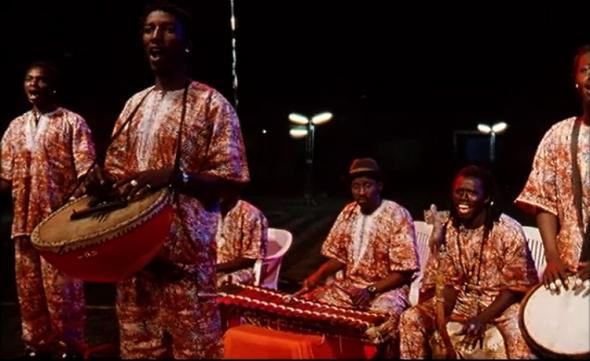 Teranga Blues, 2007, Moussa Sené Absa
Teranga Blues, 2007, Moussa Sené Absa
In the aforementioned examples, Sené Absa shows his awareness of the many roles music can play and of its crucial importance to his country’s life, both as a bond to tradition and in the opportunities it opens up for the human spirit in opposition to the hollowness and corruption endemic to modernity. His directorial praxis stresses the communicative and expressive capacities of music in their power to unify form and content, clearing new paths for experimentation; in this way, he recollects to us the importance of maintaining the spirit of those traditions of which music is the exemplar, without forgetting the challenges presented to them by contemporary life.